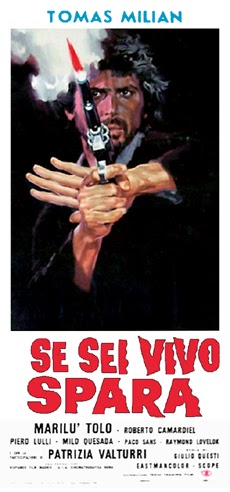 DJANGO KILL!, a prime example of the Italian “spaghetti” western as horror movie, is one of the most violent westerns made. Director Giulio Questi gives the film a haunting, surreal veneer that suits well the many horrific elements. If not for poor pacing and an overlong running time, DJANGO KILL! would be a genre classic.
DJANGO KILL!, a prime example of the Italian “spaghetti” western as horror movie, is one of the most violent westerns made. Director Giulio Questi gives the film a haunting, surreal veneer that suits well the many horrific elements. If not for poor pacing and an overlong running time, DJANGO KILL! would be a genre classic.
The long cycle of spaghetti westerns, which spanned the years 1961-75 (and spawned a few great films such as Sergio Leone’s ONCE UPON A TIME IN THE WEST and Enzo Castellari’s little-seen KEOMA), began with Leone’s A FISTFUL OF DOLLARS. Sergio Corbucci’s 1966 slaughterfest DJANGO was by no means a great film but was one of the most financially successful spaghettis. Innumerable DJANGO sequels were inevitable and unrelated films were retitled to cash in on the series popularity—such was the case with Questi’s IF YOU’RE ALIVE, SHOOT! (SE SEI VIVO SPARA), which was renamed DJANGO KILL!
DJANGO KILL! was made during the late sixties, the spag west peak period. It hits all the bases of the genre: excessive violence, an ultra-stoic Clint Eastwood-esque anti-hero, the ugliest desert landscapes you’ll ever see, and strong Gothic overtones. Any worthy spag west features at least one scene set in a graveyard, and DJANGO KILL! has more than its share!
DJANGO KILL!’s opening shot, of hands clawing their way out of an open grave, gives us fair warning not to expect a Disney flick. Those hands belong to The Stranger, a mysterious, perhaps supernatural individual (in one oft-cut scene bullets seem to pass through his body). He was left for dead by a ruthless gang of bandits who enter a community dubbed “The Unhappy Place” by locals. The town lives up its moniker when the citizens band together and murder all the bandits.
Complications ensue when a rival band of homosexual criminals enter the scene, having heard that the slain bandits carried a cache of gold which the town’s mayor now possesses. They attempt to blackmail the mayor out of his newfound treasure by kidnapping his young son and gang raping the kid (thankfully offscreen) until he commits suicide. Later, they learn that the gold may be buried in the town cemetery—in their zeal to find it the criminals proceed to dig up every grave. The Stranger for his part remains aloof, occasionally popping in to shoot somebody or romp with the madwoman locked in the mayor’s attic.
Giulio Questi directs with hallucinatory style while sticking closely to the particulars of the genre. The exteriors are drab and ugly, and none of the characters appear to have bathed in years (if ever). The violence is unusually graphic and so are the horrific scenes, in particular the Stranger’s torture by crucifixion—in a cell containing dozens of bloodthirsty vampire bats–and the evil mayor’s death, with melting gold turning his head into a gleaming mask.
But for all of its interesting qualities, Giulio Questi’s film is not one of the great spaghetti westerns. With a 2-hour plus running time, it’s overlong by at least 30 minutes. This is especially noticeable during the second half, when Questi’s pacing slows—in fact, it very nearly comes to a standstill as the film nears its conclusion, definitely a poor spot to drag!
Vital Statistics
DJANGO KILL! (a.k.a. IF YOU’RE ALIVE, SHOOT!; SE SEI VIVO SPARA)
C.I.A. Cinematographica/Hispamer Films
Director: Giulio Questi
Producer: Alex J. Rascal
Screenplay: Franco Arcalli, Guido Questi
Cinematography: Franco Delli Colli
Editing: Franco Arcalli
Cast: Thomas Milian, Marilu Tolo, Piero Lulli, Milo Quesada, Roberto Carmardiel, Patrizia Valturri
